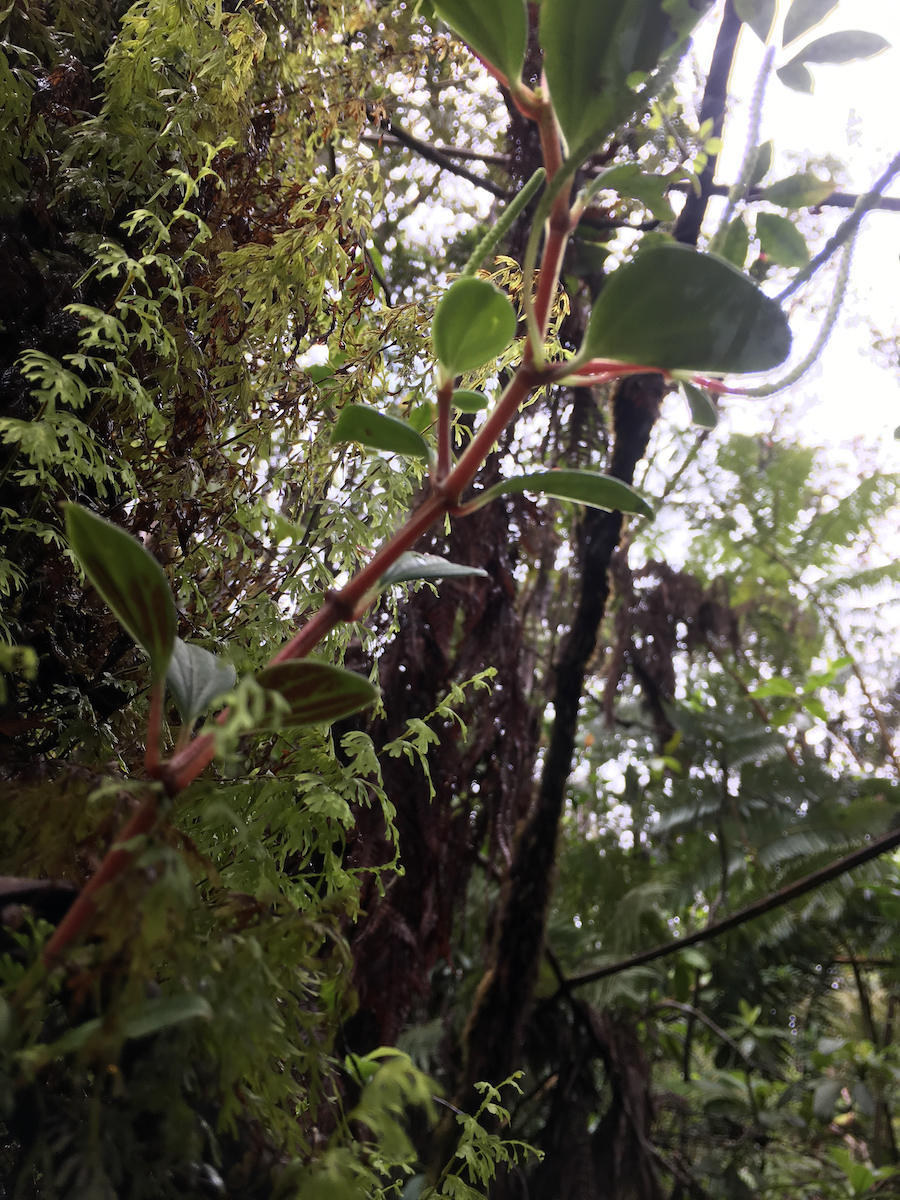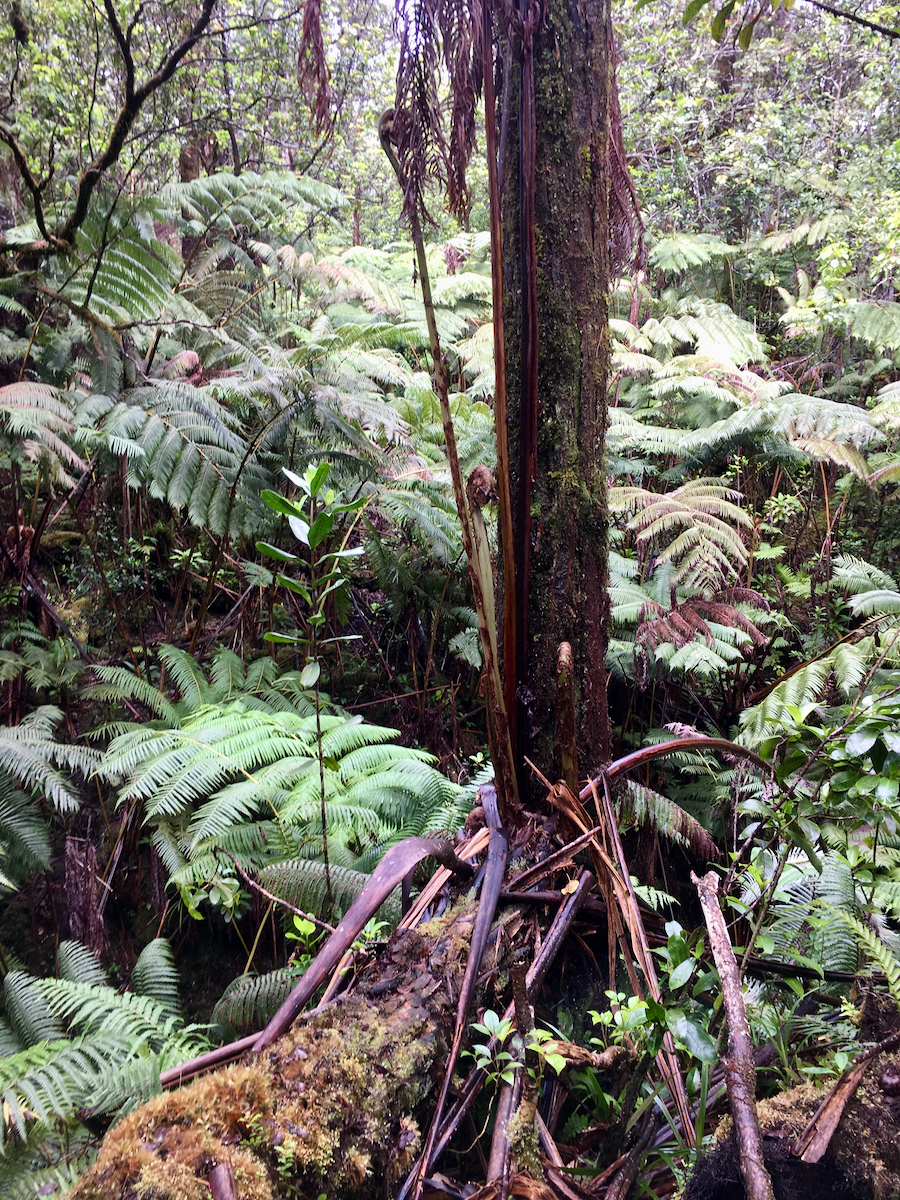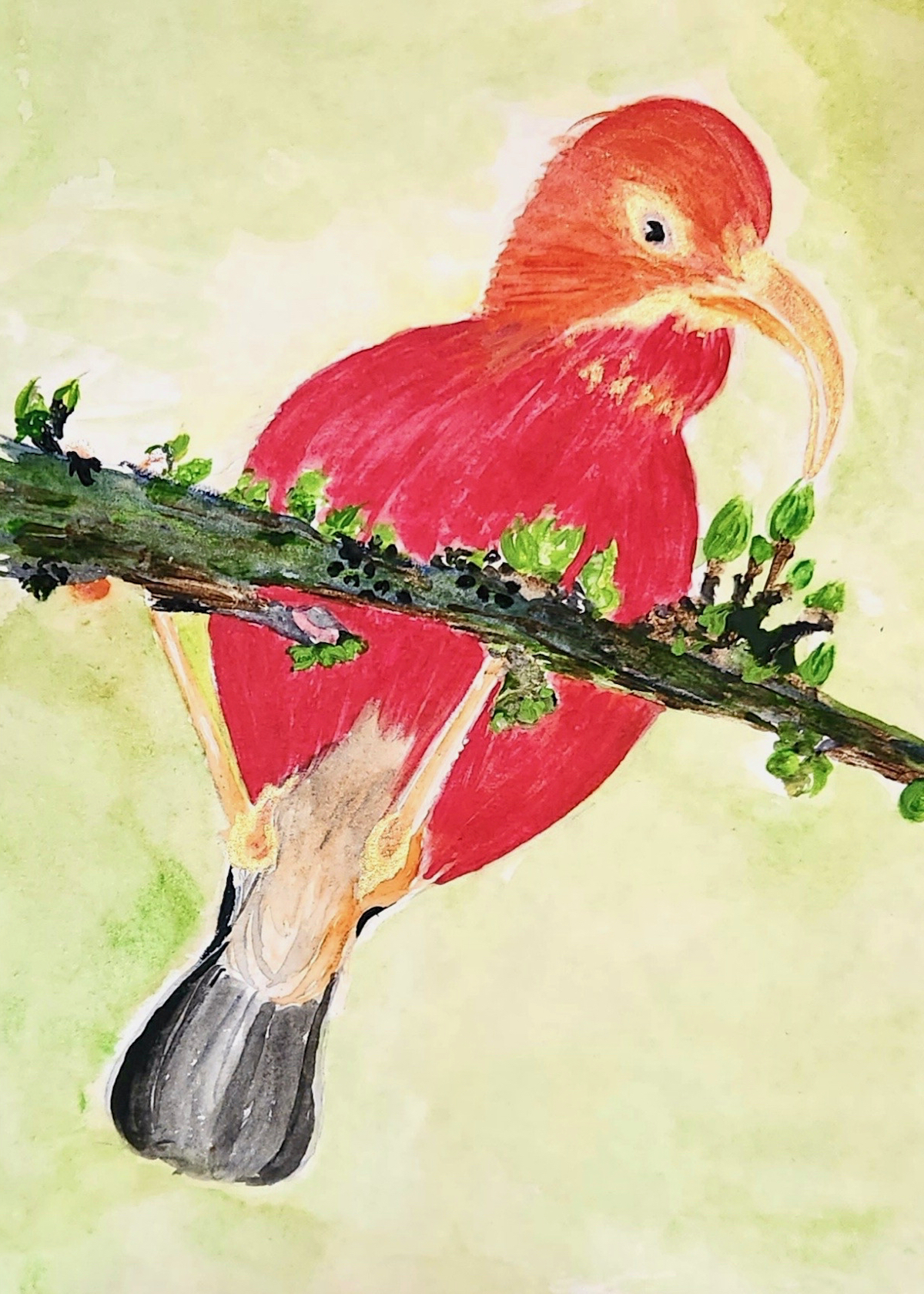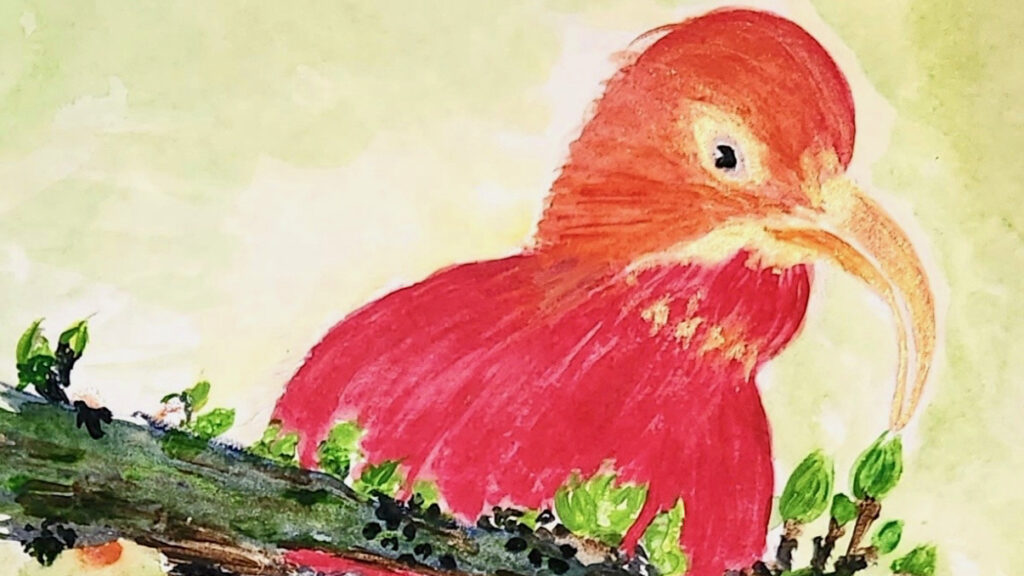Author’s note: This piece explores the intersection of culture with climate and disease ecology within high-elevation wet Hawaiian forests and the resident endemic birds. I wanted to explore what happens when these creatures, who are spiritual and cultural entities (1, 2), are no longer found in the areas where practitioners have built relationships with them, when these entities are threatened by synergistic climate impacts (3, 4). These include invasive species spread— particularly that of mosquitoes who can survive at higher elevations as temperatures warm and disease vulnerability (5)— Rapid ʻŌhiʻa Death (ROD) threatens the keystone forest trees where these birds live (6). Climatic changes are already occurring, have occurred, changing our forest places and rainfall levels (7). This piece is inspired by my family’s experiences with a very special owl who lived in the Olaʻa rainforest, not far from where this piece is storied, as well as an epic in Hawaiian tradition, Ke Kaʻao o Lāʻiekawai, as told by S.N. Haleʻole:
The main character of the epic, Lāʻiekawai, says to the guardian of her suitor, Kauakahialiʻi:
… ina e kani aku ka leo o ka Ao, aole wau iloko oia leo;
when rings the voice of the Ōʻō bird I am not in that sound;
a kani aku ka leo o ka Alala, aole no wau iloko oia leo;
on the sounding of the voice of the ʻAlalā, I am not in that sound;
ina e kani aku ka leo o ka Elepaio, hoomakaukau wau no iho aku;
when rings the voice of the ʻElepaio, I am making ready to descend;
A i kani aku ka leo o ka Apapane, alaila, ua puka wau mawaho o kuu hale nei;
when the voice of the ʻApapane sounds, then I am outside my house;
Hoolohe mau auanei oe a i kani aku ka leo o ka Iiwipolena, alaila, aia wau mawaho o ka hale o ko hanai;
listen for the voice of the juvenile ʻIʻiwi, then I am outside the house of the one in your care;
Imi ae olua a loaa wau mawaho, oia kuu manawa e launa i me ko hanai.
seek me, you two, and find me outside; that is your ward’s chance to meet me.
Kūlani Forest, Hawaiʻi Island ~2035
HIGH ABOVE THE SHADOW-DRAPED FOREST DEPTHS the red-feather-brimmed auriculars cocked towards the clumsy two-legged movements over the damp-leaf forest floor. The faraway voices echoed through the trees in undulating ripples, one voice young, high-pitched, the other tight, aged with grief. She was the eyes in the trees, the conscience of the soft misting forest: the kaumaha-weighted aloha engrained in its branches. She could feel the single-file army of fire ants invading a nearby nest. Taste the road-runoff ditch water moving through the pig carcasses left by careless hunters, the ever-encroaching weeds’ toxins tainting the old-growth soil. My forest is dying. Half of her, the part that lived among the tangled webs of green and fog, of miraculous blooming flowers and trilling bird song, tells her to ignore the voices. The other half knows that the people were a part of, not separate from the forest even if most have forgotten. The red feathers shuffle, undecided, as others respond to the voices: little blasts of color amongst the elder-trees winging their way toward the trail.
***
“Do you hear them?” Kanikau asked of himself, of his teen-aged daughter, Huelani. Every so often Kanikau would stop, in his tracks, in voice, to listen. He listened with his ears, but also with his very essence, his skin and hair, all alert to the soft drip of the misting rain through the forests’ layers, the happenings of the lush world around them.
Huelani stepped carefully into her dad’s footprints in the soft mud until she had caught up to him. Every few steps she would need to turn the step into a leap as his stride seemed to lengthen in a pattern she hadn’t yet figured out. She listened desperately too. She knew this trail well, as they had come out here with her mother many, many times when she was much younger. Her mother had loved the fern-spore-and-forest-must-air that gathered around you as you moved amongst the trees, had murmured to Huelani with un-contained joy, of the mana, spirit, of the elder trees. Huelani felt a familiar rush of grief as though she were standing at the base of a waterfall.
“No, I don’t hear anything,” Huelani said sadly. She looked over her father carefully. She knew that each visit to this forest required him to go deeper into the trees than before, follow the trail to a slightly higher elevation. And although he hid it well, Huelani knew that the shrinking native forests weighed on him heavily. This was the first time she had accompanied him into this forest since her mom had passed.
Kanikau kept up a steady chorus as they made their way further into the forest, a chorus full of warnings for Huelani to “watch her step,” or to point out a native plant— “do you see the ʻōlapa? “— that Huelani was never quite able to distinguish amidst the blurred green world as she tried to keep up. The trail was just wide enough for them to walk single-file and every so often he would stop to clip a fallen branch or move a log to maintain the trail. He went out of his way to clip the forest-invaders, the new shoots of Himalayan raspberry or Koster’s curse that were steadily penetrating the native forest.
In these still moments, Huelani would catch her breath, would gaze around at the plants closest to her. She might stash an ʻōlapa leaf in her pocket for later, the smell a comfort and reminder that this world of green, of old friends, would be there for her when she was in need. Other times she would trace the lacey wings of the hāpuʻu trunks— adorned with gardens of tiny ferns.

Photo: Ferns of the Kūlani Forest. Credit: Gina McGuire
“There!” Kanikau said with excitement. “Do you hear it?”
Huelani tore her attention away from the greenery at her fingertips and lifted her sight to the canopy. “No,” she said at first.
“Shhh,” Kanikau countered. “Listen,” he said softly, pointing towards an ʻōhiʻa branch.
Huelani couldn’t make out the bird itself, but she saw the blur of movement, the copper coloration. The next four-count-call made it clear. Eh-leh-payo. Eh-leh-payo.
“That’s a good sign,” Huelani offered. If there were ʻelepaio, there were bound to be other native birds, and the one that Kanikau searched for.
Kanikau smiled to himself. It was not who he was waiting for, but it gave him hope. ʻElepaio are the first to sing in the morning, the last to stop singing at night. Curious at their core, they were often the first to find people as they moved through the forest, as they had with canoe builders in the days of old. The endemic birds were declining, due to the increasing prevalence of disease, of the avian malaria as mosquitoes moved into higher elevations, the introduced predators, and shrinking areas of native forests. The ʻōhiʻa trees, the foundation of these forests, fraught with Rapid ʻŌhiʻa Death. He often felt helpless— it was bigger than him, out of his hands, no matter how much aloha he held for the forest, the forest people.
“I have a question for you,” Huelani offered hesitantly as her eyes remained on the blur of the ʻelepaio. Her mother had used to say, “children are meant to be seen and not heard.” And that’s how she had been raised, been taught to learn.
Kanikau gave her a shrewd look, but Huelani persisted.
“How did you know, when you saw ʻIʻiwipolena— the first time— how did you know that it was mom?”
Huelani wanted to believe, with all her heart, that the connection between her father and the bird he had spoken of, had visited for years, was real but she struggled not to be skeptical. She had been there when they had lowered the casket with her mom’s body into the earth. Had sprinkled the soil, then the flowers over the wooden case. It had been four years ago but most days it felt like yesterday. She was in the ground. And they were here, in the forest, inviting the flurry of mottled yellow-red feathers, the curved beak of the young ʻiʻiwi, the ʻiʻiwipolena, to find them amidst a shrinking forest.
“I didn’t,” he answered after a short pause. He leaned softly on a mossy ʻōhiʻa. He debated within himself, of what to say to his daughter. He felt Keawelia’s loss sharply. Everyday. Not in waves— the loss was constant although it had been four years ago. When he was in this forest, though, it was as though she were beside him. If he closed his eyes, he could feel her breath, her life presence, in the taste of the forest air. It made all the hair on his arms stand upright, his inner-most-self tremble. He both resisted and savored the feeling, but it was not something he wished for Huelani. “She’s followed me back to the truck. More than once.” She isn’t aging as quickly as the others, he might have said but he kept it to himself, for it was one of those extra-worldly traits that might bring Huelani to ask him questions he did not have the answers to.
Huelani chewed on that. Kanikau had started on the trail again and she hastened after him.
Kanikau debated within himself. They had had to walk much further into the forest to encounter an ʻelepaio than he had hoped, and the light had started to fade into the grey afternoon. He knew that the fog would come soon, streaming tightly amongst the trees as a blanket. If he had been alone, it would have been an easy decision to stay. His head told him to turn around, but his heart kept his feet moving, taking them higher up the mountain.
“You warm enough?” he asked over his shoulder. He had an emergency blanket in his small pack, but he knew she could get chilled long before night arrived.
“Yeah.”
“You sure?”
From the growing shadows a flash of white and red moved above them and he heard the ascending whistles and clicking call of an ʻapapane in flight. His mind was made for him, even if it would be a long night in the forest. ʻElepaio, ʻapapane: friends telling him he was on the right path.
“Dad, shouldn’t we turn back?” Huelani finally asked. She had been swallowing it for almost an hour, as the light trickling through the tree branches faded and the shadows lengthened around them, but she didn’t think she could hide her fear any longer. The trail, so far in, was narrower, more overgrown, and their progress was much, much slower as Kanikau stopped to cut back the tangled green. The forest was closing around them, the sky heavy: more water vapor than air, and she felt constricted in the forest’s clutches. Even if they turned around now, she didn’t think they could make it back to the truck before nightfall.
Kanikau bit the inside of his cheek as he decided. The air was chill, humid— he could feel the forest holding its breath, watching, waiting, to see if they would give up, concede that this was an elusive mission. For while the forest, the spirits, would always answer when called on, it was not always the answer that you sought. He browsed the different tones of green surrounding them, looking for something, anything to sway him one way or another. He had been so sure when he had heard the ʻapapane, that they were doing the right thing. Everything about this part of the forest told him that they were close to the realm of Paliuli, a storied place where legends walk amongst the living.
His eyes fell on a sole haʻiwale. Haʻiwale took on many different forms— was the name for the many species within the Cyrtandra family, and despite usually being found close together in tight areas, were distinct in their traits. This haʻiwale was one of the taller ones, standing just taller than Kanikau’s six feet. He knew it was haʻiwale by the serrated edges on the leaves and uniquely fuzzy stems.
“Look, kaikamahine,” Kanikau called. His eyes had caught the small orb of white, even from the twenty-feet-or-so between him and Haʻiwale.
Huelani followed him off the path, towards the strange, fuzzy plant that she had never seen before with guarded curiosity. Her eyes, too, caught the fluorescent white orbs that radiated through the shadows. Several of the tubular white flowers had opened, were downturned towards the earth, others, still wrapped tightly, faced the heavens, waiting for their turn to shine.
Kanikau brushed his fingers gently over the raindrop-decorated flowers, careful not to knock the delicate flowers from their stems. He knew that this particular haʻiwale only grew here, in this forest. Was found nowhere else in the whole world. He lamented to himself that he had not prepared Huelani for moments like this, for the possibility that the most worthwhile endeavors required a good deal of grit.
He pressed the droplets into his chest and as though the forest had been waiting for this gesture, with a sigh the fog descended around them.
“We’ll spend the night here.”
***
“Is it like ʻaumakua?” Huelani asked. “I’m starving,” she muttered to herself.
Kanikau pondered that for a moment as he packed up the water and silver blanket that she had slept in. ʻAumakua was the Hawaiian term for an ancestor that had assumed the form of something that could hold spirit: rocks, clouds, plants…
“It’s that but its more than that.” He looked at his daughter scarf down the energy bar he had packed. She was more than half Keawelia— her nose, her eyes, her delicate bones, and he ached for his best friend. “You’re in Physics, right?” he asked.
“Yeah,” she answered.
“You guys get to the law of physics?”
“For every action there is an equal and opposite reaction,” she recited like she was reading out of a textbook.
Kanikau chuckled. “No, not that one.” He tried to find the right words. “The one about mass.”
“Mass?”
“Yeah, substance. The substance we’re all made out of.” Kanikau chewed the inside of his cheek. He had not been in a classroom for a long time. He was a fisherman— he couldn’t remember the last time had said the word ‘mass’ out loud.
He continued slowly. “Within the system, the amount of mass must stay the same over time…. Constant.”
“Ok?”
Kanikau could see it wasn’t clicking. “You can’t add or subtract matter from the whole. It only transforms.” Kanikau watched his daughter carefully to see if there was a glimmer of recognition in her eyes.
“Maybe,” Huelani said with a defiant jut of her chin.
“The same thing is true of spirit. And I don’t know that the ʻiʻiwipolena is of spirit. I believe. I can feel it, like when you feel the wind on your skin.” He tilted his closed eyes up, towards the forest canopy and felt the trickle of the raindrops down his eyelids, silently thanking the forest for this blessing. “You don’t need to see it to know that it’s there.” He felt silly saying this but since he had lost his love, he had been feeling his mortality. He wanted her to know this, in case, in case, just in case… but he wondered if she was at that age: young but at the same time, also old, just not young, or old enough, to have the faith she needed.

Photo: The Kūlani Forest. Credit: Gina McGuire
When she didn’t say anything, he continued. “Do you know what intuition is?”
“No,” Huelani answered truthfully. She was getting confused, and she felt uncomfortable, had always felt strange when he spoke in this way. It was too lofty, too removed from the ‘real’ world. No one practiced the old ways anymore.
Kanikau sighed tiredly. Just as he opened his mouth to answer, he heard it. What they had come so far for. The soft whistle trilled behind him and he knew without turning around, that she had come.
“Listen,” he breathed, wanting to remember the moment so that he could hold it with him as he moved through each day with the hollow indentation in his chest she had once filled.
“Keawelia,” he whispered and turned to greet her. He gazed up at the singer, who fluttered down several branches to a tree some ten feet away. Her feathers had become more scarlet, with faint yellow undertones since his last visit. But she was still polena, still a juvenile ʻiʻiwi. Just as before, a resounding joy filled him, a certainty.

Mixed media of ʻIʻiwipolena, contributed by LOI.
With a cheerful warble, the ʻiʻiwi landed on his shoulder and he stood frozen, his breathing heavy with the weight of the moment. ʻIʻiwi’s deep, black eyes traveled from the face of the kanikau[/simple_tooltip], her living lament, to that of the girl before her.
There would be a day, when ʻIʻiwi’s heart stilled, when she too, would be laid to rest in the soft soils of the forest, for even ʻuhane kiaʻi, guardian spirits, fade. And before her time, she needed Huelani, the gourd containing the heavens, as was the girl’s name, to waken. Grant her eyes to see beyond her sight, she prayed. For the forest would only persist as the culture lived. She pressed her curved beak against Kanikau’s warm, steady pulse. She knew how much she loved them, how much she loved the forest, because of the soft pain in her breast. E ke akua, e pale ʻoukou ia mākou. Safeguard us, the descendants of the trees.
Map: I’iwi habitat and ʻōhiʻa forest decline in Hawai’i, 2023
This map shows the extent of ʻiʻiwi habitat (outlined in red) as it overlaps confounding threats including one of the pathogens driving ʻōhiʻa forest decline (orange) and the climatic mosquito line (black outline)— below this elevation mosquitoes actively transmit Avian malaria to Hawaiʻi’s endemic birds such as the ʻelepaio, ʻapapane, and ʻiʻiwi highlighted in this story.
Layer citations & information:
- ʻIʻiwi critical habitat designation (FWS 2022)
- Modeled potential presence of Ceratocystis luhuohia Fortini, L.B., Kaiser, L.R., Keith, L.M., Price, J., Hughes, F., Jacobi, J.D., and Friday, J.B., 2019, Hawaiian Islands Ceratocystis rapid ohia death spatial analysis 2019: U.S. Geological Survey data release, https://doi.org/10.5066/P94ESGQB.
“Hawai’i’s most widespread native tree, ʹōhiʹa lehua (Metrosideros polymorpha), has been dying across large areas of Hawai’i Island mainly due to two fungal pathogens (Ceratocystis lukuohia and Ceratocystis huliohia) that cause a disease collectively known as Rapid ʹŌhiʹa Death. Here we examine patterns of positive detections of C. lukuohia as it has been linked to the larger mortality events across Hawai’i Island.”
- 4,500 ft elevational contour line for Hawaiʻi Island ~ “mosquito line” under current climatic conditions: above which mosquitoes cannot survive the cool climate at altitude & Avian malaria cannot develop.
Layer made from USGS 1983 elevational data

